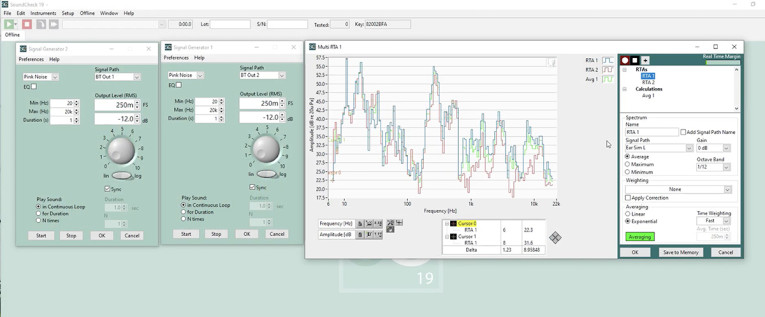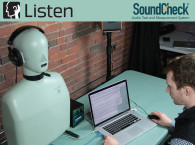
In the updated software, the multi-channel RTA feature allows displaying multiple channels or signal paths and the spectrum settings such as gain, octave band, weighting, averaging and time-weighting, all independently configured for each channel for complete measurement flexibility.
A power averaging calculation on the signal paths can be used for spatial and sound power measurements and all multi-channel RTA functionality can also be used within a test sequence for automation. The ability to display multiple channels or signal paths presents a convenient view of many measurements across a wide range of applications. These include overlaying left and right earphone responses to check for fit and seal, microphone array captures (e.g. in-vehicle cabin measurements), real time adjustment of active noise cancellation filter, and more.
The new RT60 Room acoustics module in SoundCheck 19 offers extremely fast measurement of the reverberation time (signal decay time) and clarity (ratio of early reverberations to late reverberations) of any room or space. This functionality is useful for quantifying how speakers will interact with the acoustics of a particular type of room. The integration of the RT60 functionality within SoundCheck provides the user the assurance that measurements can be performed with calibrated signal paths.

SoundCheck 19 In Detail
In this release, the original ANSI S1.11-2004 Class 0 standard compliant, single-channel RTA has been enhanced to show multiple channels simultaneously. Settings for these can be configured independently, e.g. adding different weighting curves, and the power-averaged response displayed. This presents a convenient view of many measurements across a wide range of applications including overlaying left and right earphone responses to check for fit and seal, microphone array captures (e.g. in-vehicle cabin measurements), real time adjustment of active noise cancellation filter, and more. For maximum flexibility, spectrum settings are set independently for each channel, and all multi-channel RTA functionality can also be used within a test sequence for automation.

The optional RT60 Room Acoustics module (shown above) enables measurement of the reverberation time and clarity of any room or space with fully calibrated signal paths. This is useful for quantifying how speakers will interact with the acoustics of a particular type of room. It can also help identify problems with room acoustics so that the floor, ceiling and walls can be treated accordingly. SoundCheck uses a continuous sine sweep with the Log TSR algorithm to obtain the impulse response. The reverberation decay curve is calculated from the backwards integrated impulse response. This method, conforming to ISO 3382-1:2009, offers extremely fast measurements, requires just one measurement at each location, and minimizes the effect of noise and distortion on the measurement.
Another SoundCheck 19 enhancement is the option to use WASAPI-exclusive mode with Windows 10 audio devices. This advanced interface offers superior communication with audio devices, allowing SoundCheck to bypass the Windows audio engine, and send audio streams directly to the device. This delivers lower latency and ensures that sample rate conversion from the built-in Windows audio engine will not occur. It also enables SoundCheck to put an exclusive lock on the audio interface so that a measurement cannot be disrupted by system sounds. The ability to use multiple WASAPI devices simultaneously offers significant advantages for multichannel applications, particularly where the channel count requires multiple audio interfaces. WASAPI and ASIO devices can be combined to increase channel availability.

SoundCheck 19 supports AmpConnect 621, Listen’s new high resolution (up to 192kHz) multichannel audio interface. This multichannel interface was specifically developed for test applications such as automotive audio, sound power measurements, and measuring devices with multiple speakers such as smart phones or sound bars. In addition to 6 inputs and 2 outputs, AmpConnect 621 also includes microphone power, full TEDS calibration support, impedance measurement and digital I/O in a single USB-connected unit. Designed for seamless integration with SoundCheck, it is controlled exclusively via the SoundCheck software. True plug and play makes configuration automatic and extremely fast whether it is a single installation or a large scale factory implementation, and there are no front panel buttons, eliminating the possibility of accidental changes to the settings.
Set-up and configuration of AmpConnect 621 is extremely simple and fast with full plug-and-play functionality and TEDS support for automatic identification, configuration and calibration of microphones and accelerometers. The absence of front panel knobs also provides an added level of test integrity by ensuring that settings cannot be inadvertently adjusted outside of your test configuration. SoundCheck 19 with AmpConnect 621 is a simple and cost-effective solution for automotive measurements with a 6-microphone array, sound power measurements, or for measuring devices with multiple speakers such as smartphones or sound bars.
Also new in SoundCheck 19 is a diagnostic window which enables suppression of warning dialog windows when running a sequence, logging any errors, warnings, and information in a separate file. This is useful when Soundcheck is run in unattended or in highly automated situations (for example, on a production line) where dialog windows would interrupt the execution of a sequence. It also facilitates troubleshooting as the log is easily shared via email.
In both Windows and MacOS, SoundCheck also now allows the Dock USB Controller Knob to be used to adjust the SoundCheck Signal Generator, simulating the feel and control of operation of a traditional manual analog signal generator. Used with other virtual instruments such as the RTA, spectrum analyzer and distortion meter, this offers a rapid way to identify defects by observing the response while manually fine-tuning the signal generator.
www.listeninc.com







